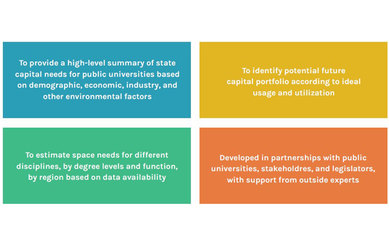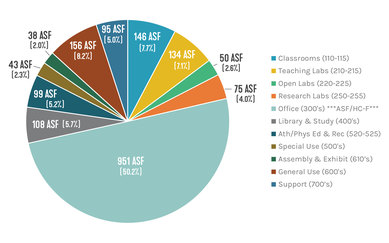Oregon Higher Education Coordinating Commission Strategic Capital Development Plan
Wise, data-informed decisions begin with quality data. With comprehensive analyses of existing space, academic programming, and future needs of its universities, the State of Oregon can more effectively allocate funding to its higher education system.
Client
Oregon Higher Education Coordinating Commission
Location
State of Oregon
Markets/Services
Campus Strategy & Analytics, Higher Education
As the liaison between Oregon’s seven statewide public universities and the Oregon Legislature and executive branch, the Oregon Higher Education Coordinating Commission wanted to improve its strategic decision making for the state’s higher-education system.

In particular, the Commission wanted more data about physical space utilization on each campus, along with analyses of existing academic program capacity and how it related to future workforce needs.
The study illustrated for state leaders how well the existing physical assets and academic programming at each university aligned with the types of careers that were in need in the state of Oregon—clarifying how Oregon’s higher education system could lead to greater job creation and growth within the state.
SmithGroup conducted a full analysis of space on seven campuses across the state. The study used graphical information system (GIS) capabilities to geo-map key sets of data about population growth, enrollment numbers, and demographics to project future academic and space needs. The National Center for Higher Education Management Systems provided an assessment of enrollment projections and workforce demand for academic programs.
This body of work was a colossal two-year collaborative with the Higher Education Coordinating Commission, the seven public universities, and local workforce boards. The result of this work is used frequently. SmithGroup adeptly quantified the magnitude of capital needs, deferred maintenance requirements, utilization of space in simple terms, and enrollment patterns with likely forecasts for the next ten years. This clear road map continues to drive decision making at the Higher Education Coordinating Commission and with our state legislature.
Jim Pinkard
Postsecondary Finance and Capital, State of Oregon Higher Education Coordinating Commission
By layering the GIS findings with existing space allocation and academic program findings, the study provided the state with a valuable “big picture” overview of how and where its capital appropriations would be most effective.

Findings revealed that the system didn’t lack overall space but would benefit from reallocating and upgrading existing space. The study recommended that each university identify and focus on its key strengths, which would eliminate costly duplication of programs and enable the universities to collaborate, rather than compete, with one another. Other recommendations include upgrades for 21st-century learning, more funding for deferred maintenance, and demolition of buildings that cannot be remodeled or repurposed in support of current and future needs.
The team shared its findings at legislative hearings and prepared a report for the governor’s office and Oregon Legislature, prior to the legislature finalizing capital appropriations for the coming year. Informed with current data and new insights, state leaders were able to make the most of taxpayer dollars, providing funding where it will better serve students and strengthen Oregon’s economy.
